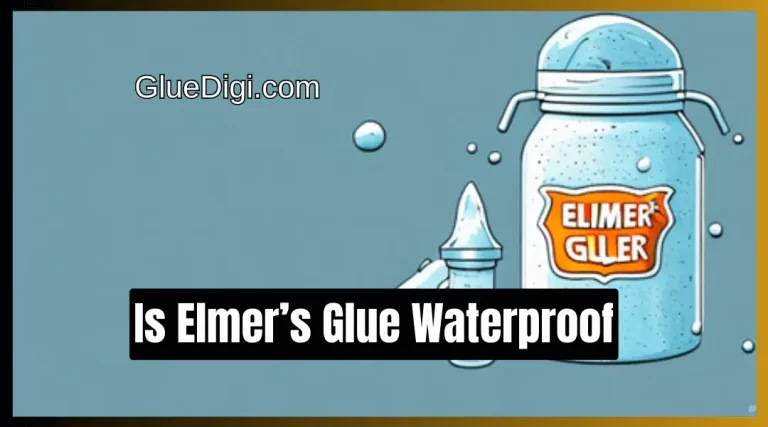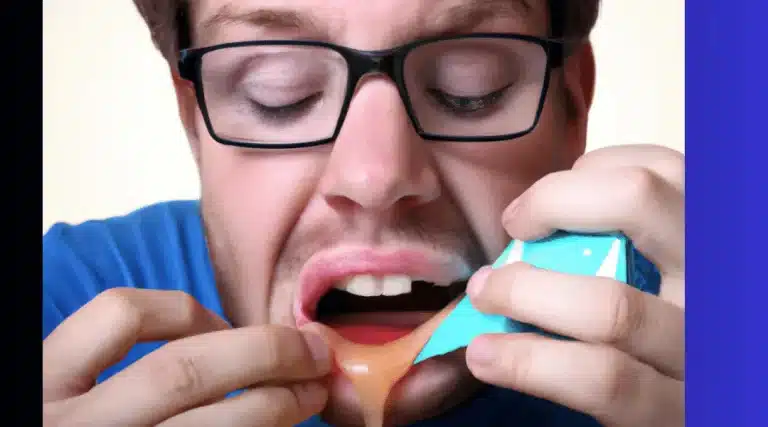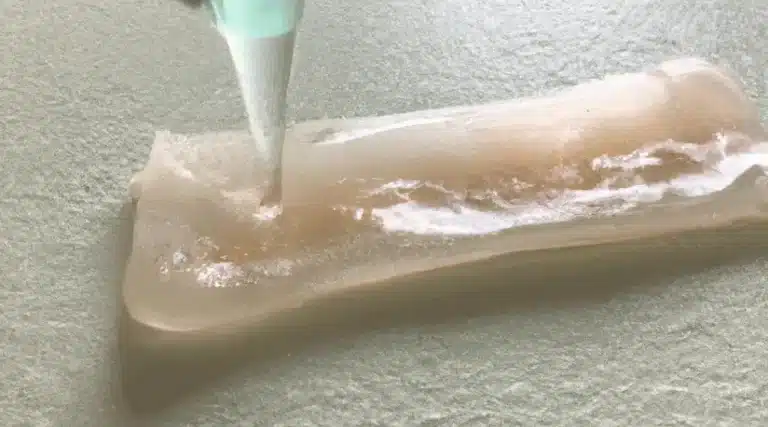Do you ever find yourself in need of a strong adhesive to fix or create something? That’s where glue comes in! Glue is a versatile substance that can be used for various projects, from repairing broken items to creating new ones.
But what exactly is it, and how does it work? Glue is a type of adhesive that bonds two surfaces together. It works by creating a chemical reaction between the glue and the surface it is applied to, which causes them to stick together.
There are different types of glue available on the market, each with its own composition and uses. From white glue to super glue, epoxy glue to contact cement, and wood glue to fabric glue – the choices can be overwhelming.
In this article, we’ll take a closer look at what each type of glue consists of and its specific applications so that you can choose the right one for your project. Plus, we’ll provide some tips on how to use them safely and effectively so that you can enjoy your newfound freedom in fixing or creating anything you want!
What is Glue and How Does it Work?
You’ll be amazed at how this sticky substance works its magic, binding two surfaces together with incredible strength and creating an unbreakable bond that can withstand even the toughest of forces.

Glue has a long history dating back to ancient times when animal hides were boiled down to create a sticky solution. Today, we have a vast array of glues available to us, each with its unique chemical reactions and adhesive properties.
Chemical reactions are what make glue work. When you apply it to one surface and join it with another, the adhesive properties in the glue create a chemical reaction that results in an incredibly strong bond.
But not all adhesives are created equal; some may be too weak for certain applications while others may be too strong and difficult to remove. That’s why there are alternative adhesives like double-sided tape or spray adhesive that can offer different levels of stickiness depending on your needs.
In industrial applications, glue is used in everything from construction materials to car parts and electronics assembly. Now let’s move on to white glue: composition and uses!
White Glue: Composition and Uses
White glue, also known as school glue or PVA glue, is an essential item in any crafter’s toolkit due to its ability to bind materials such as paper, cardboard, and wood together with ease. Its composition mainly consists of polyvinyl acetate (PVA), which is a water-based polymer that forms a strong adhesive bond when it dries.
One of the benefits of using white glue is that it dries clear, which makes it perfect for arts and crafts projects where aesthetics are important. To apply white glue, simply spread a thin layer onto one surface and press the other surface on top of it.
Some popular brands of white glue include Elmer’s Glue-All and Aleene’s Original Tacky Glue. If you’re looking for alternatives to white glue, there are other types of adhesives like rubber cement or hot glue that may be better suited for certain materials or applications.
With this knowledge about white glue in mind, let’s move on to the next section about super glue: composition and uses without losing sight of our subconscious desire for freedom.
Super Glue: Composition and Uses
Get ready to experience the sheer strength of a tiny drop as we explore the wonders of this adhesive powerhouse: super glue. Known for its bonding strength, super glue is a type of cyanoacrylate adhesive that is commonly used in various applications such as woodworking, metalworking, and even medical procedures.
It works by forming an instant bond when it comes into contact with moisture, which can be found in the air or on surfaces. However, it’s important to take safety precautions when handling super glue due to its fast-drying nature and ability to bond skin together. To avoid any accidents, make sure to wear gloves and work in a well-ventilated area.
Also, keep in mind that once applied, it cannot be easily undone without special solvents. With that said, super glue is definitely a go-to option for those looking for quick and strong bonding solutions.
As we move onto the next section about epoxy glue: composition and uses, you’ll discover another popular adhesive known for its versatility and durability.
Epoxy Glue: Composition and Uses
You’re about to discover the incredible strength and endless possibilities of this mighty adhesive: epoxy. Epoxy is a two-part adhesive that consists of an epoxy resin and a hardener. When mixed together, they create a chemical reaction that results in a strong bond. Epoxy has become increasingly popular due to its versatility and durability.
Here are some applications for epoxy bonding:
- Woodworking – Epoxy can be used to fill gaps in wood or as an alternative to traditional wood glue.
- Automotive repair – Epoxy can be used to fix cracks or holes in car parts such as bumpers or headlights.
- Jewelry making – Epoxy can be used as an adhesive for attaching gems or other materials onto jewelry pieces.
- Metal bonding – Unlike super glue, epoxy can bond metal surfaces together effectively.
One thing to keep in mind when using epoxy is its curing time, which is typically longer than super glue. However, the extra wait time pays off with a stronger bond overall, making it worth the wait.
If you need an adhesive for heavy-duty projects like metal bonding, then consider giving epoxy a try before reaching for super glue.
Moving on from the power of epoxy, let’s dive into another type of adhesive: contact cement and its composition and uses.
Contact Cement: Composition and Uses
Are you ready to discover the game-changing adhesive that’ll revolutionize your DIY projects and leave you wondering how you ever lived without it? Introducing contact cement and its incredible composition and uses.
Contact cement is a type of cement adhesive known for its exceptional bonding strength and industrial applications. It’s made up of solvent-based formulas that allow it to bond two surfaces together permanently.
One of the most remarkable features of contact cement is its drying time. Unlike other glues, contact cement requires both surfaces to be coated with glue before they can be joined. Once applied, the glue needs to dry completely before joining the surfaces together, which usually takes about 15-20 minutes. This makes it an ideal choice for those who want a quick solution for their DIY projects.
Now let’s move on to hot glue: composition and uses…
Hot Glue: Composition and Uses
If you’re someone who loves to get creative and doesn’t want to wait around for glue to dry, hot glue might just be your new best friend. Hot glue is a type of adhesive that’s melted in a special gun-like tool and applied directly onto the surfaces you want to bond together. It quickly solidifies as it cools down, resulting in a strong and durable bond.
Here are 5 reasons why hot glue might be perfect for you:
- Hot glue can be used for DIY projects such as scrapbooking, card-making, and creating decorations.
- It can also be used for industrial applications such as packaging, product assembly, and even automotive repairs.
- Hot glue has a high melting point, making it resistant to heat and ideal for use on materials that’ll be exposed to high temperatures.
- Safety precautions should always be taken when using hot glue as it can cause burns if it comes into contact with the skin.
- The bonding strength of hot glue varies depending on the material being bonded together but generally provides a stronghold.
Moving on from hot glue, let’s take a look at wood glue which is another popular adhesive used in woodworking projects.
Wood Glue: Composition and Uses
If you thought hot glue was versatile, wait until you hear about wood glue. Woodworking applications are where this type of adhesive really shines. There’s likely a wood glue that can bond your pieces together with ease, whether you’re building a cabinet or fixing a chair leg.
Wood glues come in many different types, including waterproof options for outdoor projects and variations specifically designed to bond with different wood types. Some wood glues can even outperform traditional nails and screws when it comes to strength comparison. The only downside is the longer drying time compared to hot glue – typically around 24 hours for full curing.
But if you have the patience, the strong and lasting bonds created by wood glue are well worth it in the end.
Now let’s move on to fabric glue: composition and uses!
Fabric Glue: Composition and Uses
You’ll be pleasantly surprised by the versatility and strength of fabric adhesives, making them an excellent choice for a variety of DIY projects. Whether you’re fixing a torn hemline or creating a unique piece of clothing, fabric glue offers many benefits over traditional sewing methods.
Fabric glue is easy to use and dries quickly, making it perfect for those who don’t have the time or patience for hand-sewing. When it comes to choosing the right fabric glue for your project, there are two main types: permanent and temporary.
Permanent fabric glue creates a strong bond that can withstand multiple washings and wearings, while temporary fabric glue allows you to easily remove your project without damaging the material. While there are alternatives to using fabric glue such as fusible webbing or sewing techniques like applique, many people prefer the ease and convenience of using fabric adhesive.
Some popular brands include Aleene’s Original Tacky Glue and Dritz Liquid Stitch. Now that you know about the benefits of fabric glue, let’s move onto choosing the right adhesive for your project without compromising quality or durability.
Choosing the Right Glue for Your Project
Now that you know about fabric glue and its uses, it’s important to choose the right adhesive option for your project.
There are various factors to consider when selecting a glue, such as material compatibility, drying time, strength requirements, and environmental considerations.
For instance, if you’re working with delicate materials like lace or silk, you might want to opt for a spray adhesive or a fabric-specific glue that won’t leave any residue or marks.
If you need a strong bond for heavier fabrics like denim or leather, then a heavy-duty glue like epoxy may be more suitable.
Additionally, some glues dry quickly while others take longer to set – so make sure to factor in the drying time before starting your project.
Lastly, if you have any environmental concerns regarding the type of glue used in your project (e.g., toxicity), be sure to research eco-friendly options that meet your needs.
By considering these factors beforehand, you can ensure that your finished product is not only beautiful but also functional and long-lasting.
As always with any crafting or DIY projects involving adhesives – it’s important to use them effectively and safely.
Here are some tips on how to do just that…
Tips for Using Glue Effectively and Safely
To make your crafting experience safe and enjoyable, follow these tips for using adhesives effectively.
First and foremost, always take safety precautions when working with glue. This includes wearing gloves to protect your hands from the chemicals in certain types of glue and ensuring that you’re working in a well-ventilated area to avoid inhaling fumes.
When applying glue, it’s important to use proper application techniques to ensure that the adhesive forms a strong bond. Start by applying a thin layer of glue evenly across the surface you want to adhere. Make sure not to apply too much or too little glue as this can affect the drying time and strength of the bond.
Speaking of drying time, always be patient and allow enough time for the adhesive to dry completely before handling or moving your project.
Lastly, storage tips for unused adhesive include tightly sealing the container after use and storing it in a cool, dry place away from direct sunlight. In case you accidentally get excess glue on surfaces like tables or clothes, clean up immediately with warm soapy water or using solvents recommended on the product label.
Conclusion
Congratulations! You’ve learned about the different types of glue and their uses. Now, you can choose the right glue for your project with confidence.
Remember to consider factors such as materials being used, strength needed, and drying time when selecting a glue.
To use glue effectively and safely, follow these tips: always read instructions carefully before starting; apply the right amount of glue for your project; avoid skin contact with strong glues such as superglue or epoxy; work in a well-ventilated area; and store your glue in a cool, dry place away from children and pets.
With these tips and knowledge of different types of glue, you’re ready to tackle any DIY project that comes your way.
Happy crafting!




